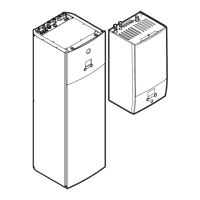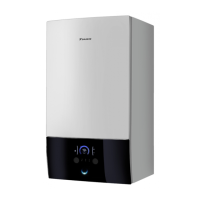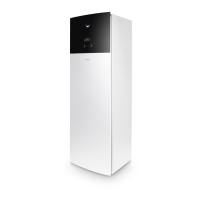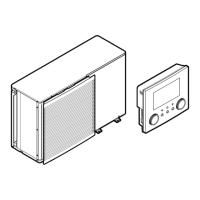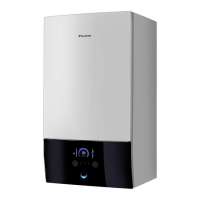4 Set-up and installation
Installation and maintenance instructions
20
Daikin Altherma EHS(X/H)(B)-D
Heat pump (indoor unit) with integrated heat accumulator
008.1444099_01 – 11/2018 – EN
CAUTION
If the indoor unit is connected to a cold water line where
steel pipes are used, chips can get into the stainless steel
corrugated pipe heat exchanger and remain there. This
can lead to contact corrosion damage and subsequently to
leakage.
▪ Flush the feed pipes before filling the heat exchanger.
▪ Install the dirt filter in the cold water supply (e.g. SAS 1
or SAS 2).
CAUTION:BIV ONLY
If the heat exchanger for pressurised solar system char-
ging (see Chap. 4.1, items8+ 9) is connected to an ex-
ternal heater (e.g. wood-burning boiler), the indoor unit
can be damaged or destroyed due to an excessively high
inflow temperature at these connections.
▪ The inflow temperature of the external heating unit
should be limited to max. 95°C.
CAUTION
Corrosion may be caused by air entering the heating water
network and by a quality of the heating water that does not
comply with the requirements in accordance with Require-
ments for the heating water. Corrosion products (particles)
thus created may clog pumps and valves and cause mal-
functions.
▪ Device may not be connected by permeable, flexible
lines.
▪ For potable water lines, observe the provisions of EN806,
DIN1988 and the additional applicable national regulations for
potable water installation.
▪ Install the indoor unit close to the withdrawal point to dispense
with the need for a circulation line. If a circulation line is mandat-
ory, it must be installed according to the schematic diagrams in
Chap. 6.1.
4.6.1 Connecting hydraulic lines
DANGER: RISK OF BURNING
There is a danger of scalding at hot water temperatures
over 65°C. This is possible when using solar energy if an
external heater is connected, the Legionella protection is
activated, or the target hot water temperature is set to be
greater than 65°C.
▪ Install a scalding protection (hot water mixer device (e.g.
VTA32)).
INFORMATION
The indoor unit is equipped with a pressure sensor. The
system pressure in monitored electronically and can be
displayed with the device switched on.
Nevertheless, we recommend installing a mechanical pres-
sure gauge between the indoor unit and the diaphragm ex-
pansion vessel, for example.
▪ Install the pressure gauge so that it is easy to see when
filling.
1 Check the cold water connection pressure (maximum 6bar).
▪ If a higher pressure is present in the domestic water pipe, a
pressure reducer will need to be installed.
2 Fix the hydraulic block in place with a screwdriver.
Fig.4-27 Fix the hydraulic block in place when connecting to the
top (left) or to the rear (right)
3 Establish hydraulic connections to the indoor unit.
▪ Refer to Chap. 4.1 for the position of the heater connections.
▪ Observe specified tightening torque (see Chap. 10.4)
▪ Install the line in such a way that the protective cover is simple
to put on after assembly.
▪ Connect the water for filling or refilling the heating system as
specified by EN1717/EN61770 to avoid contamination of
drinking water by return flow.
4 For rearward facing connections: Support hydraulic lines suit-
ably according to the spatial conditions.
Fig.4-28 Connection to the rear: Support hydraulic lines
5 Connect the blow-off line to the safety over-pressure valve and
diaphragm expansion vessel in accordance with EN12828.
▪ Any steam or heating water which may escape must be drained
by a suitable blow-off line with constant gradient in a frost-pro-
tected, safe and observable manner.
▪ Install the line in such a way that the protective cover is simple
to put on after assembly.
▪ Check the seat of the drain hose on the safety pressure relief
valve. If necessary, connect and install a separate hose.
6 Connecting a diaphragm expansion vessel.
▪ Connect a suitably dimensioned and preset diaphragm expan-
sion vessel for the heating system. There may not be any hy-
draulic blocking elements between the heat generator and the
safety valve.
▪ Position the diaphragm expansion vessel in an easily access-
ible place (maintenance, parts replacement).

